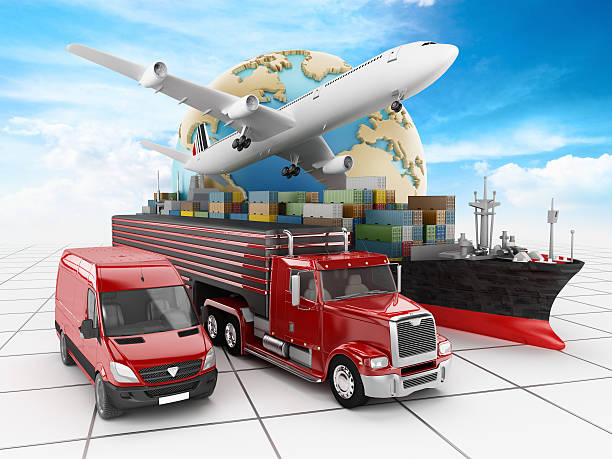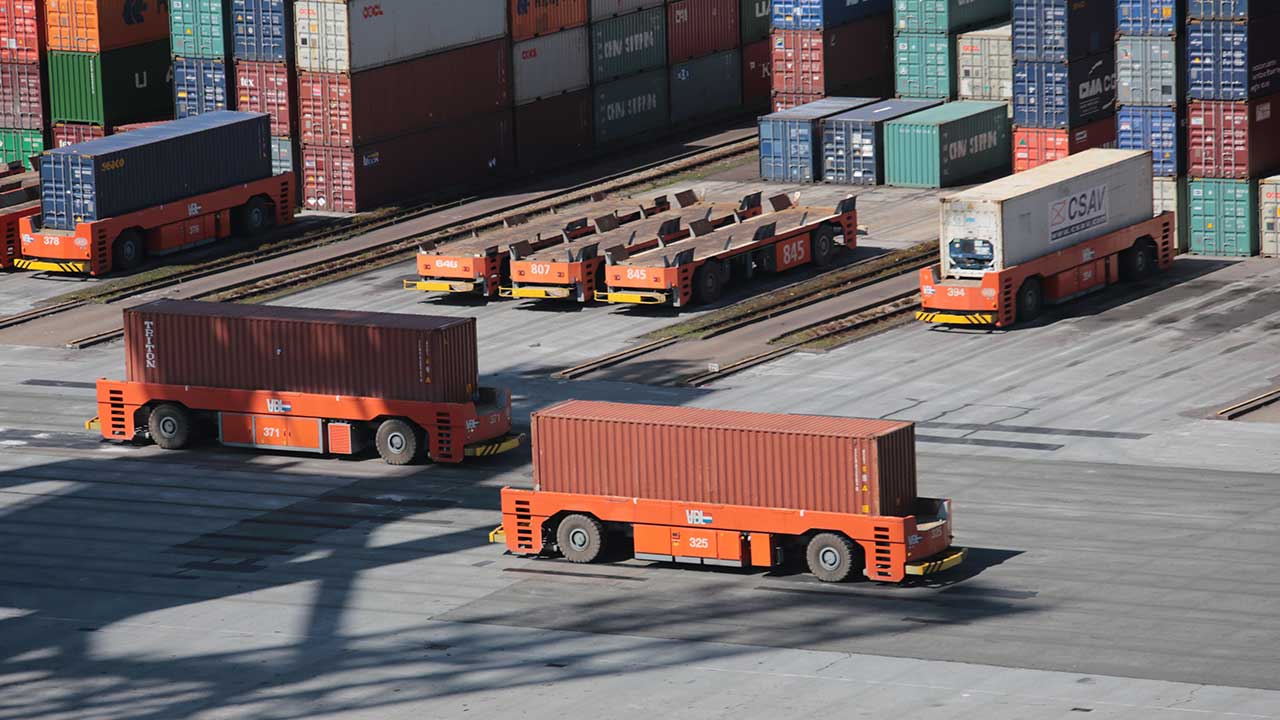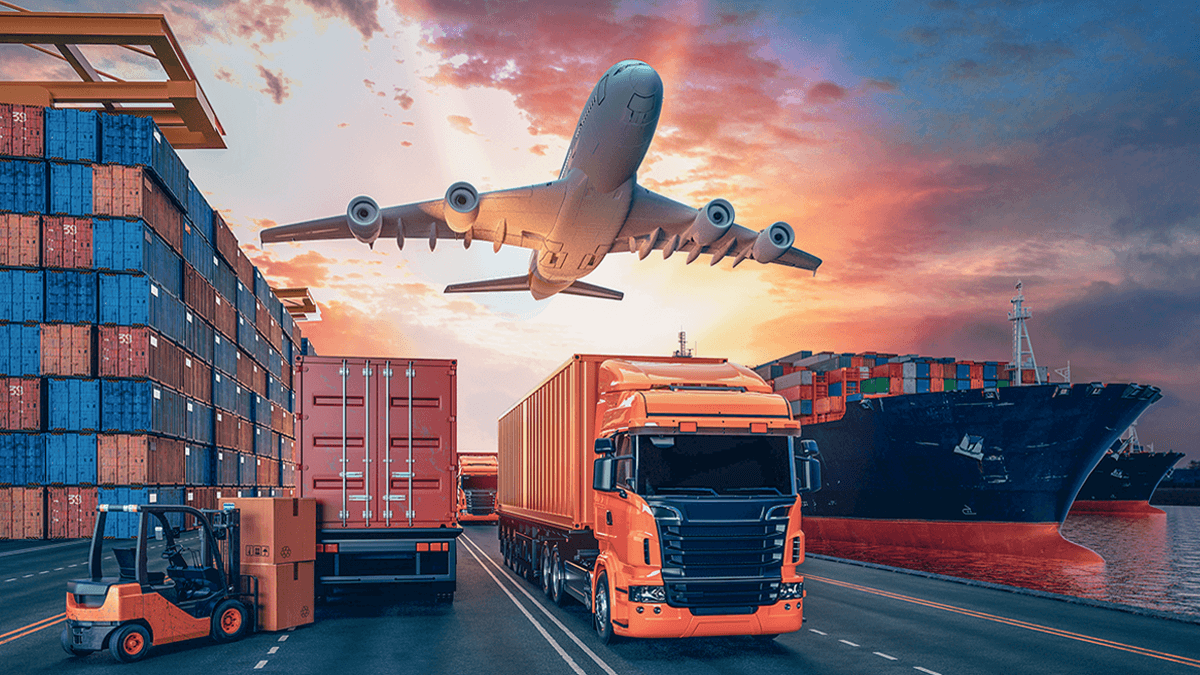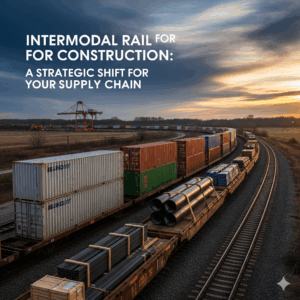Editor’s note: This post was initially published on December 19th, 2021 and has since been revised for comprehensiveness
In today’s fast-evolving global logistics landscape, multimodal transportation has emerged as a critical solution for businesses looking to optimize their supply chains. As companies face increasing pressure to deliver faster, more cost-efficient, and environmentally sustainable freight services, understanding the nuances between multimodal transportation and its close cousin, intermodal transportation, is vital for success in 2024.
At its core, multimodal transportation involves the movement of goods using two or more different transportation modes—such as rail, truck, sea, or air—under a single contract or bill of lading. This contrasts with traditional single-mode shipping, which relies solely on one transport type. In 2024, leveraging multimodal transportation can unlock unparalleled advantages in speed, cost control, and environmental footprint, making it a go-to option for shippers in Canada, the U.S., and around the world.
What is Multimodal Transportation?
Multimodal transportation refers to the seamless use of multiple modes of transport—like rail, road, sea, and air—in a single supply chain operation. This means your cargo could begin its journey by ocean freight, transfer to rail for long-haul land movement, and then finish with trucking for last-mile delivery, all coordinated under one contract. The key benefit is that you, as a shipper, interact with a single logistics provider responsible for the entire journey, simplifying management and accountability.
The growing complexity of global trade routes and the expansion of e-commerce have increased demand for integrated shipping solutions. In response, multimodal transportation offers businesses an agile framework to adapt quickly to changing market conditions and customer expectations.
Intermodal Transportation: A Key Component of Multimodal
While the terms are often used interchangeably, intermodal transportation is a subset of multimodal transportation with a specific focus: moving freight in standardized containers that transfer across multiple transport modes—primarily truck and rail—without unpacking the goods.
Intermodal shipping’s hallmark is efficiency and security. For example, a container might be loaded at a manufacturing facility, hauled by truck to a rail terminal, shipped cross-country by train, then delivered by truck to its final destination—all without ever opening the container. This eliminates handling damage, reduces transit times, and enhances cargo security.
In 2024, intermodal transportation is a powerhouse for cost savings and sustainability, especially for long-distance shipments within Canada and between Canada and the U.S. Rail networks operated by CN and CP provide reliable service connecting key industrial hubs, making intermodal transportation increasingly accessible for Canadian businesses.
Why Multimodal Transportation Matters in 2024
The logistics industry faces unprecedented challenges—from rising fuel prices and driver shortages to stricter environmental regulations. In this context, multimodal transportation offers a strategic advantage by combining the strengths of different transport modes to overcome limitations inherent in any single mode.
- Cost Efficiency: By optimizing mode combinations, shippers can reduce overall freight spend. For example, ocean freight is cost-effective for transpacific shipping, while rail offers cheaper inland transport compared to trucking. Combining these creates a leaner supply chain.
- Improved Transit Times: While some modes are slower but cheaper (like ocean or rail), others offer speed (like trucking and air). Multimodal enables businesses to balance speed and cost by selecting the best mode for each leg.
- Environmental Benefits: With growing corporate responsibility for sustainability, multimodal transportation supports carbon footprint reduction. Rail and sea modes emit significantly less greenhouse gases per ton-km than trucking or air freight, helping companies meet 2024’s stricter emission targets.
- Increased Supply Chain Resilience: Diversifying transportation modes reduces risk. If a trucking strike, rail delay, or port congestion impacts one mode, goods can often be rerouted via another. This flexibility is critical in a volatile global market.
How Multimodal Transportation Works: Key Components
Successful multimodal transportation relies on coordination between multiple carriers, terminals, and logistics providers. Here are the main components:
- Single Contract/Carrier Responsibility: Unlike booking separate contracts for each leg, multimodal shipments operate under a unified bill of lading or contract. This centralizes liability and simplifies claims if problems arise.
- Seamless Cargo Transfer: Cargo transfers between modes happen at specialized terminals or hubs—such as seaports, rail yards, and inland ports. Efficient transfer processes minimize delays and handling damage.
- Standardized Containers: Use of containers that meet international standards enables smooth intermodal and multimodal transitions, reducing unpacking and repacking needs.
- Advanced Technology: Real-time tracking, electronic documentation, and Transportation Management Systems (TMS) are essential to monitor cargo movement, optimize routes, and maintain transparency.
Multimodal Transportation Trends to Watch in 2024
Several emerging trends are shaping the future of multimodal transportation in 2024:
- Digital Integration and Automation: Enhanced data sharing and automation streamline coordination between modes. Digital freight platforms now provide instant quotes, booking, and real-time visibility.
- Sustainability Focus: Regulatory pressures and consumer demand accelerate adoption of greener transport modes like rail and sea. Companies integrate carbon reporting into their freight strategies.
- Last-Mile Innovation: The rise of e-commerce is pushing innovation in the last-mile segment, blending multimodal networks with urban delivery solutions like electric vehicles and micro-fulfillment centers.
- Infrastructure Investments: Governments in Canada and beyond are investing billions in rail, port, and inland terminal upgrades to support higher volumes and faster intermodal/multimodal flows.
Why Canadian Businesses Should Embrace Multimodal Transportation
For Canadian businesses, adopting multimodal transportation in 2024 offers unique benefits:
- Access to vast rail networks connecting East and West coasts, facilitating cross-Canada shipping.
- Proximity to major U.S. markets with integrated cross-border multimodal routes.
- Ability to manage seasonal fluctuations with flexible mode switching.
- Compliance with Canada’s ambitious climate goals by shifting freight to greener modes.
- Improved supply chain reliability amid ongoing labor shortages and global disruptions.
Getting Started with Multimodal Transportation
Implementing multimodal transportation involves evaluating your shipping profile, volumes, routes, and priorities. Working with experienced providers and freight brokers specializing in multimodal services helps you design a tailored solution.
A typical approach includes:
- Mapping existing freight flows and identifying modal bottlenecks.
- Comparing costs and transit times for various mode combinations.
- Selecting the optimal multimodal carrier partnerships.
- Integrating technology tools for visibility and control.
- Monitoring performance and adjusting as market conditions evolve.
As 2024 unfolds, multimodal transportation stands out as a strategic, cost-effective, and sustainable way to manage freight. Its ability to combine the strengths of rail, road, sea, and air under one coordinated plan empowers Canadian businesses to meet evolving customer demands, reduce environmental impact, and enhance supply chain resilience.
Whether you’re a manufacturer, retailer, or logistics manager, mastering multimodal transportation will be key to unlocking growth and competitive advantage this year. Embrace the future of freight by exploring multimodal solutions that fit your business needs and take advantage of the innovations transforming the industry today.

What Is Multimodal Transportation?
Multimodal transport facilitates efficient cargo movement from origin to destination, utilizing multiple modes like trucks, trains, and ships. This railway method is managed by specialized Multimodal Transport Operators (MTOs). As it offers cost-effective solutions for both domestic and international freight, Multimodal has been a go to for businesses.
How Does Multimodal Transportation Work?
In international multimodal transport, a single document known as a bill of lading governs the entire shipment. A single carrier, the Multimodal Transport Operator (MTO), handles the movement, with payment made through a flat-rate fee.
The MTO plays an important role in:
- Planning the route: Determining the most efficient and cost-effective path for your goods.
- Contracting with carriers: Arranging transport with individual companies for each leg of the journey.
- Calculating costs: Accurately estimating the total cost based on the services involved.
- Taking full responsibility: Ensuring your goods reach their destination safely and securely.
- Managing transportation: Overseeing the movement of goods across different modes (sea, rail, road, etc.).
- Terminal leasing: Securing specialized facilities for handling and storage.
- Customs clearance: Handling all necessary paperwork and procedures.
- Additional services: Providing further support like auditing and equipment leasing.
The process typically involves:
Customer request
Contacting a multimodal transport company with relevant information about your goods and desired destination.
Cargo inspection and planning
Company representatives verify the cargo, documentation, and plan the route, calculating costs.
Contract and cargo collection
Signing the contract and handing over your goods to the carrier.
Transportation
Smooth and efficient movement of goods as per the planned route.
The Advantages and Disadvantages Of Multimodal Shipping
Like every mode of transportation available, multimodal shipping has many advantages and disadvantages.
The Advantages of Multimodal Shipping Are
Centralized Control
By offering multimodal transportation, your company takes charge of the entire logistics process, providing a one-stop solution for customers. This centralized control gives you a competitive edge and allows you to manage and plan operations according to your expertise.
Competitive Fares
Multimodal transportation often enables you to negotiate better prices with individual carriers due to your broader perspective of the entire shipping process. This translates into more competitive fares for your customers, making your services more attractive.
Increased Agility
Multimodal transportation significantly reduces shipping times by streamlining the entire process under one roof. This agility is particularly beneficial for customers who prioritize speed and efficiency in their supply chains.
The Disadvantages of Multimodal Shipping Are
Specialization and Partnerships
While many forwarders excel in specific areas like air or sea freight, offering multimodal transportation requires expertise in organizing solutions across all modes. This often necessitates significant investments in staff, infrastructure, and equipment. Additionally, building strong partnerships with reliable international logistics providers is crucial for seamless overseas operations.
Increased Bureaucracy
Each transport mode has its own regulations and distinct documentation requirements. Providing a comprehensive logistics service encompassing multiple modes demands extensive customs knowledge to navigate the complexities of multimodal transportation. Depending on the operation’s complexity, managing this bureaucracy can be a significant undertaking.
What Is Intermodal Transportation and how is it different?
Intermodal transport differs from multimodal transport in two key ways. First, multiple providers handle different segments of the shipment, each with its own bill of lading and responsibility. Second, it typically uses trucks and trains for the entire journey, offering flexibility through multiple handoffs.
How Does Intermodal Transportation Work?
An intermodal shipment typically involves three distinct stages:
Origin Drayage
A specialized intermodal driver, known as a drayman or drayage carrier, retrieves an empty container from the origin rail ramp and delivers it to the shipper.
Once loaded by the shipper, the drayman returns the container to the rail ramp.
Rail Linehaul
The railroad transports the container from the origin rail ramp to the destination rail ramp.
Destination Drayage
The destination drayage carrier picks up the container from the ramp and delivers the shipment to the final receiver.
The Advantages and Disadvantages Of Intermodal Shipping
Just like multimodal shipping, Intermodal has its fair share of advantages and disadvantages.
Let’s look into it –
The Advantages of Intermodal Shipping Are:
Cost Reductions
Combining the efficiency of rail and truckload transportation leads to cost advantages and improved operational efficiency. Utilizing rail for long-distance hauls and trucks for short-distance drayage provides shippers with increased flexibility, better service, and lower costs.
The less drayage involved in a specific route, the more competitive the intermodal rate becomes compared to truckload rates.
High Capacity
Intermodal transportation offers rapid access to a large pool of truckload solutions due to its operational flow. Drayage typically stays below 100 miles, allowing a single driver to make multiple turns delivering loads to and from intermodal ramps. Compared to truckload, where a driver might travel 2,000-3,000 miles before picking up a new load, this significantly improves turnaround times, particularly beneficial in times of driver shortages.
Enhanced Visibility
Contrary to a common misconception, intermodal transportation offers excellent visibility throughout the journey. Each container is scanned upon entering and leaving intermodal ramps, and its location is tracked during rail transport. This allows for real-time monitoring from origin to destination.
Reliability and Security
Intermodal transportation provides a safe and secure method that minimizes cargo handling during transport. This reduces the risk of damage and loss while enhancing security at terminals, rail tracks, and ramps.
Environmentally Friendly
Intermodal transportation boasts significant environmental benefits, contributing to sustainability. Rail is a highly fuel-efficient mode of transport, requiring less fuel per ton of freight compared to trucks. This translates to reduced greenhouse gas and carbon emissions during long-distance shipments.
Ideal for High-Value Products
Standard CORGI liability coverage for intermodal transportation provides up to $250,000, offering significant protection for valuable goods. Additionally, with minimal drayage, the cargo remains within the container for most of the journey, minimizing opportunities for theft.

The Disadvantages of Intermodal Shipping Are:
Transit Times
Intermodal shipments typically require more planning and are slower than traditional truckload transportation. Expect transit times to be one day longer than a truckload shipment, and even longer if multiple railroads are involved.
Blocking and Bracing
Securing cargo within intermodal containers can be complex and time-consuming. The specific requirements can vary, and the cost of proper blocking and bracing may outweigh the potential savings.
Commodity Restrictions
Certain commodities may be restricted or even prohibited for intermodal transport. Prohibited items require special agreements with the railroad, and restricted commodities often have lower liability coverage than standard shipments.
Weight Limitations
Intermodal shipments have a maximum load weight of 42,500 pounds. While the container and chassis are lighter than some truck trailers, this may limit the amount of cargo you can load compared to a truckload shipment.
Limited Reach
Intermodal transportation is not available for every origin and destination combination. The finite number of intermodal railroad ramps and the typical 100-mile drayage range limit the reach of this method.
Small Shipments
Intermodal transport may not be suitable for smaller shipments due to the volume required to obtain contractual pricing. Securing guaranteed pricing and capacity for a year often requires a minimum of three loads per week on the specific route.
A Summary Of The Points Talked About
| Feature | Multimodal Transport | Intermodal Transport |
| Managed By | Multimodal Transport Operator (MTO) | Multiple carriers |
| Documentation | Single bill of lading | Multiple bills of lading |
| Control | Centralized control by MTO | Decentralized control by individual carriers |
| Flexibility | Highly flexible. Can use any mode of transport. | Less flexible. Primarily uses trucks and trains. |
| Complexity | More complex due to multiple modes and regulations | Less complex due to focus on trucks and trains. |
| Cost | Potentially more competitive fares | Cost-effective for long distances. |
| Speed | Faster due to streamlined process | Slower than truckload transport. |
| Visibility | Good visibility throughout the journey | Excellent visibility with real-time tracking. |
| Security | Minimizes cargo handling, reduces risk of damage and loss | Secure method with minimal drayage. |
| Sustainability | Environmentally friendly due to efficient rail usage | More eco-friendly than truckload transport. |
| Suitability for High-Value Goods | Well-suited with standard liability coverage | Ideal due to minimal drayage and secure containers. |
| Disadvantages | Requires expertise and partnerships. Increased bureaucracy. | Slower transit times. Complex cargo blocking and bracing. May not be suitable for some special cargo. Weight limitations. Limited reach. Unsuitable for small shipments. |
So, What To Choose Between Intermodal And Multimodal Transportation?
In the world of shipping goods, two main methods dominate the landscape: intermodal and multimodal transportation. Understanding these options is crucial for ensuring your products reach their final destination efficiently.
Both intermodal and multimodal transportation offer distinct advantages, making the ideal choice dependent on your specific needs and the characteristics of your cargo. Ultimately, the best method hinges on your priorities, such as speed, cost, or flexibility.
So, review your business and select the one that best suits all your needs.
Conclusion
As we wrap up this comprehensive guide to intermodal and multimodal transportation in 2024, it’s clear that embracing multimodal solutions is no longer just an option—it’s a necessity for businesses aiming to thrive in today’s complex logistics environment. From improving cost-efficiency and transit reliability to advancing sustainability goals, multimodal transportation offers a robust framework to transform how Canadian and global businesses move goods.
Unlocking Cost Savings and Efficiency with Multimodal Transportation
One of the most compelling reasons to adopt multimodal transportation is the significant cost savings it unlocks. By intelligently combining modes such as rail, truck, and ocean freight, companies can optimize shipping routes, reduce fuel expenses, and lower overall freight costs. For instance, the strategic use of rail for long-haul segments dramatically cuts transportation expenses compared to exclusive trucking, which tends to be more costly over long distances.
Moreover, the integration of multimodal transportation reduces the operational complexity of managing multiple carriers and contracts. Instead, shippers benefit from a single contract or bill of lading, simplifying administrative work and centralizing responsibility. This not only saves time but also mitigates risks and administrative errors, ultimately enhancing supply chain efficiency.
Enhancing Supply Chain Resilience through Mode Diversification
Supply chain disruptions have become a frequent reality in recent years due to labor shortages, extreme weather events, and geopolitical uncertainties. In this context, multimodal transportation provides much-needed resilience by enabling shippers to diversify their transportation modes.
If one mode experiences delays or capacity constraints—for example, trucking shortages or port congestion—companies can pivot to alternative modes such as rail or sea freight. This flexibility keeps goods moving and reduces the likelihood of costly downtime or missed deadlines. In 2024, as global supply chains continue to face uncertainty, multimodal solutions ensure businesses remain agile and adaptable.
Meeting Sustainability Targets with Multimodal Transportation
Environmental responsibility is at the forefront of corporate priorities, and multimodal transportation is a powerful enabler of greener logistics. Rail and ocean freight modes produce significantly lower greenhouse gas emissions compared to trucks and airplanes, often emitting up to 75% less CO2 per ton-kilometer.
By incorporating rail and sea into your freight strategy, your business can substantially reduce its carbon footprint. This shift is not just beneficial for the planet but also aligns with evolving regulations and consumer expectations for sustainable practices. In Canada and globally, sustainability targets for 2024 and beyond increasingly favor companies that integrate multimodal transportation into their supply chains.
Leveraging Technology for Seamless Multimodal Integration
The effectiveness of multimodal transportation in 2024 hinges on the seamless integration of technology. Advanced transportation management systems (TMS), digital freight platforms, and real-time tracking tools provide full visibility into cargo movement across all transport modes.
These technologies enable proactive management of multimodal shipments, allowing businesses to optimize routes, anticipate delays, and communicate transparently with customers. Furthermore, electronic documentation and automated billing streamline operations and reduce paperwork, improving accuracy and speed.
Investing in these digital tools enhances your ability to capitalize on multimodal efficiencies, turning complex logistics into a smooth, well-orchestrated process.
Choosing the Right Partners for Multimodal Success
Successfully implementing multimodal transportation requires collaboration with experienced logistics providers who specialize in multimodal and intermodal services. These partners bring critical expertise in route planning, carrier coordination, customs clearance, and cargo handling across modes.
In Canada, working with established providers ensures access to the extensive rail networks operated by Canadian National (CN) and Canadian Pacific (CP), as well as integrated cross-border solutions with the U.S. This connectivity is essential for optimizing multimodal freight flows and securing competitive rates.
By partnering with knowledgeable multimodal carriers and brokers, you gain strategic guidance and operational support to maximize your supply chain’s performance in 2024.
Practical Steps to Implement Multimodal Transportation Today
To fully leverage multimodal transportation benefits, start by assessing your current freight operations. Identify long-haul routes that could benefit from rail or ocean integration, evaluate freight volumes, and analyze transit time requirements.
Next, explore potential multimodal carriers and technology solutions to support your logistics needs. Pilot projects can be a low-risk way to test multimodal shipping on select routes before scaling up.
Finally, continuously monitor performance metrics such as cost per shipment, transit times, and carbon emissions to refine your multimodal strategy. In doing so, your supply chain will become more efficient, resilient, and sustainable.
The Future of Freight Is Multimodal
As 2024 progresses, the importance of multimodal transportation will only intensify. Shippers who harness its power position themselves at the forefront of supply chain innovation—reducing costs, mitigating risks, and meeting sustainability commitments.
From Canadian manufacturers to international exporters, integrating multiple modes of transport into a cohesive strategy is the smartest way to scale logistics in today’s dynamic market. The flexibility, efficiency, and environmental benefits of multimodal transportation make it indispensable for competitive advantage now and in the years ahead.
Final Thought: Start Your Multimodal Journey with RailGateway
For businesses ready to embrace the future of freight, partnering with industry leaders like RailGateway can simplify your transition to multimodal transportation. With deep expertise in Canadian intermodal and multimodal solutions, RailGateway offers tailored shipping services, cutting-edge technology, and a trusted network of carriers.
Explore how RailGateway can help optimize your supply chain in 2024 and beyond by visiting railgateway.ca.

FAQ’s
What Is The Difference Between Intermodal And Intramodal Transportation?
In simple terms, “inter” means between different places, while “intra” means within one place. However, transporting things over long distances often involves using multiple methods, even if the starting and ending points are different locations. This applies to both passenger and cargo transportation.
What Is An Example Of Intermodal Transportation?
Intermodal transportation offers an efficient way to travel by utilizing two or more modes of transport for a single journey. This can enhance the travel experience by leveraging the strengths of each mode. For instance, a trip might involve a comfortable bus ride between cities, followed by a high-speed train journey to reach the final destination. The train segment exemplifies intermodal transportation in this scenario.
What Is An Example Of Multimodal Transportation?
Multimodal transportation encompasses a diverse range of travel options, including walking, cycling, public transit, rail, cars, and trucks. It essentially refers to the movement of both people and goods across various transportation networks. This includes, but is not limited to, motorists, passengers utilizing public transit, freight carriers, cyclists, pedestrians, and those with disabilities.





